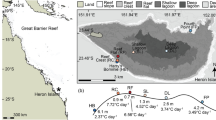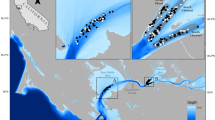Abstract
An experimental system is described that is capable of maintaining precise and stable thermoclines of specified magnitude for laboratory study of behavior of planktonic organisms. Behavioral responses to encounters with thermoclines of various magnitudes were measured in stage I larvae of the portunid crab Callinectes sapidus Rathbun. Larvae adapted to an initial temperature of 15°C were able to swim up through a temperature gradient of 10°C, but showed increasing inhibition of upward migration when Δt=12.5°C. Larvae adapted to 17.5°C were unable to penetrate Δt=10°C. Thermoclines of 5° or 10°C slowed passive sinking rates. Results suggest that larvae avoid an upper temperature of 27.5°C by a cessation of swimming, accompanied by passive sinking. Thermal gradients of the magnitude present in the natural habitat are unlikely to alter larval vertical migration that is regulated by other exogenous stimuli. Naturally occurring thermoclines should seldom influence dispersal characteristics of C. sapidus larvae.
Similar content being viewed by others
Literature cited
Churchill, E. P.: Life history of the blue crab. Bull. U.S. Bureau of Fisheries, Document 870, 96–123 (1919)
Epifanio, C. E., C. C. Valenti and A. E. Pembroke: Dispersal and recruitment of blue crab larvae in Delaware Bay, U.S.A. Estuar. coast. Shelf Sci. 18, 1–12 (1984)
Fisher, W. S. and R. T. Nelson: Application of antibiotics in the cultivation of dungeness crab, Cancer magister. J. Fish. Res. Bd Can. 35, 1343–1349 (1978)
Harder, W.: Reactions of plankton organisms to water stratification. Limnol. Oceanogr. 13, 156–168 (1968)
Incze, L. S. and C. M. Yentsch: Stable density fronts and dinoflagellate patches in a tidal estuary. Estuar. coast. Shelf Sci. 13, 547–556 (1981)
Kieffer, D. A. and J. N. Kremer: Origins of vertical patterns of phytoplankton and nutrients in the temperate open ocean: a stratigraphic hypothesis. Deep Sea Res. 28A, 1087–1105 (1981)
Kinne, O.: Temperature. In: Marine ecology, pp 407–514. Ed. by O. Kinne. New York: Wiley Interscience 1970
Lance, J.: Effects of water of reduced salinity on the vertical migration of zooplankton. J. mar. biol. Ass. U.K. 42, 131–154 (1962)
Longhurst, A. R. and A. W. Herman: Do oceanic zooplankton aggregate at, or near, the deep chlorophyll maximum? J. mar. Res. 39, 353–356 (1981)
Ortner, P. B., P. H. Wiebe and J. L. Cox: Relationships between oceanic epizooplankton distributions and the seasonal deep chlorophyll maximum in the northwestern Atlantic Ocean. J. mar. Res. 38, 507–531 (1980)
Ott, F. S. and R. B. Forward, Jr.: The effect of temperature on phototaxis and geotaxis by larvae of the crab Rhithropanopeus harrisii (Gould). J. exp. mar. Biol. Ecol. 23, 97–107 (1976)
Provenzano, A. J., Jr., J. R. McConaugha, K. B. Phillips, D. F. Johnson and J. Clark: Vertical distribution of first stage larvae of the blue crab, Callinectes sapidus, at the mouth of Chesapeake Bay. Estuar. coast. Shelf Sci. 16, 489–500 (1983)
Roberts, M. H., Jr.: Larval development of Pagurus longicarpus (Say) reared in the laboratory. III. Behavioral responses to salinity discontinuities. Biol. Bull. mar. biol. Lab., Woods Hole, 140, 489–501 (1971)
Seitz, R. C.: Temperature and salinity distributions in vertical sections along the longitudinal axis and across the entrance of Chesapeake Bay (April 1968–March 1969). Chesapeake Bay Institute Graphical Summary No. 5. The Johns Hopkins University, 99 pp. 1971
Seliger, H. H., J. A. Boggs, R. B. Rivkin, W. H. Biggley and K. R. H. Aspden: The transport of oyster larvae in an estuary. Mar. Biol. 71, 57–72 (1982)
Seliger, H. H., K. R. McKinley, W. H. Biggley, R. B. Rivkin and K. R. H. Aspden. Phytoplankton patchiness and frontal regions. Mar. Biol. 61, 119–131 (1981)
Sokal, R. R. and F. J. Rohlf: Biometry, 776 pp. San Francisco: W. H. Freeman and Co. 1969
Stroup, E. D. and R. J. Lynn: Atlas of salinity and temperature distribution in Chesapeake Bay, 1952–1961. Chesapeake Bay Institute, Graphical Summary No. 2, The Johns Hopkins University, 409 pp. 1963
Sulkin, S. D.: The significance of diet in the growth and development of larvae of the blue crab Callinectes sapidus (Rathbun) under laboratory conditions. J. exp. mar. Biol. Ecol. 20, 119–135 (1975)
Sulkin, S. D.: Nutritional requirements during larval development of the portunid crab Callinectes sapidus (Rathbun). J. exp. mar. Biol. Ecol. 34, 29–41 (1978)
Sulkin, S. D., C. E. Epifanio and A. J. Provenzano, Jr.: The blue crab in mid-Atlantic bight estuaries: a proposed recruitment model. Technical Report, Maryland Sea Grant Program. No. UM-SG-TS-82-04. University of Maryland, 36 pp. 1982
Sulkin, S. D. and W. Van Heukelem: Larval recruitment in the crab Callinectes sapidus Rathbun: an amendment to the concept of larval retention in estuaries. In: Estuarine comparisons, pp 459–475. Ed. by V. Kennedy, New York: Academic Press 1982
Sulkin, S. D., W. Van Heukelem, P. Kelly and L. Van Heukelem: The behavioral basis of larval recruitment in the crab Callinectes sapidus Rathbun: a laboratory investigation of ontogenetic changes in geotaxis and barokinesis. Biol. Bull. mar. biol. Lab., Woods Hole 159, 402–417 (1980)
Thorson, G.: Light as an ecological factor in the dispersal and settlement of larvae of marine bottom invertebrates. Ophelia 1, 167–208 (1964)
Author information
Authors and Affiliations
Additional information
Communicated by S. K. Pierce, College Park
Contribution No. 1535 of the Center for Environmental and Estuarine Studies, University of Maryland
Rights and permissions
About this article
Cite this article
McConnaughey, R.A., Sulkin, S.D. Measuring the effects of thermoclines on the vertical migration of larvae of Callinectes sapidus (Brachyura: Portunidae) in the laboratory. Mar. Biol. 81, 139–145 (1984). https://doi.org/10.1007/BF00393112
Accepted:
Issue Date:
DOI: https://doi.org/10.1007/BF00393112




